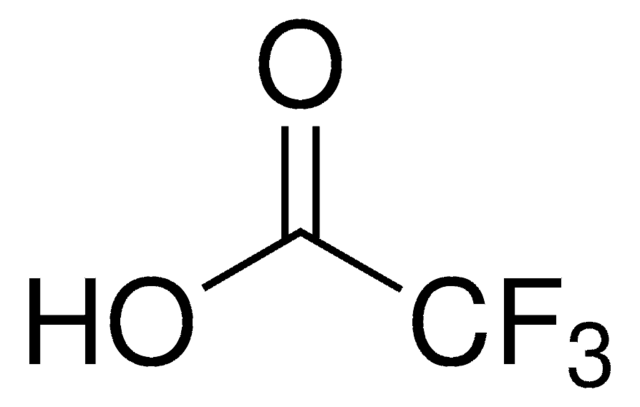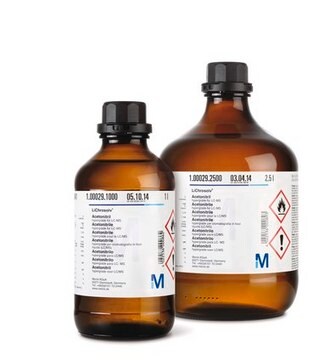추천 제품
vapor density
3.9 (vs air)
Quality Level
vapor pressure
97.5 mmHg ( 20 °C)
유형
for protein sequencing
분석
≥99%
양식
liquid
불순물
<0.05% water
증발 잔류물
<0.005%
refractive index
n20/D 1.3 (lit.)
pH
1 (20 °C, 10 g/L)
bp
72.4 °C (lit.)
mp
−15.4 °C (lit.)
density
1.489 g/mL at 20 °C (lit.)
SMILES string
OC(C(F)(F)F)=O
InChI
1S/C2HF3O2/c3-2(4,5)1(6)7/h(H,6,7)
InChI key
DTQVDTLACAAQTR-UHFFFAOYSA-N
유사한 제품을 찾으십니까? 방문 제품 비교 안내
일반 설명
Trifluoroacetic acid is a naturally occurring organic solvent and biodegradable by microbial action. It can also be used as a catalyst for various organic transformations, including solvolysis, rearrangements, reductions, oxidations, and trifluoromethylation.
애플리케이션
Trifluoroacetic acid can be used as a solvent in the:
- Mass spectrometry for protein identification.
- Microwave-irradiated bromination of isoxazoles and pyrazoles with N-bromosuccinimide to synthesize mono-brominated isoxazoles and pyrazoles.
- Lewis acid-catalyzed 6-endo-digcyclization of 2-(2-arylethynyl)heteroaryl esters to heterocyclic lactones.
- Electrospinning of cellulose acetate to prepare the corresponding nanofibrous membranes.
신호어
Danger
유해 및 위험 성명서
Hazard Classifications
Acute Tox. 4 Inhalation - Aquatic Chronic 3 - Eye Dam. 1 - Skin Corr. 1A
Storage Class Code
8A - Combustible corrosive hazardous materials
WGK
WGK 2
Flash Point (°F)
No data available
Flash Point (°C)
No data available
Andrew C Tolonen et al.
Journal of visualized experiments : JoVE, (89)(89), doi:10-doi:10 (2014-07-22)
Stable isotope labeling of peptides by reductive dimethylation (ReDi labeling) is a method to accurately quantify protein expression differences between samples using mass spectrometry. ReDi labeling is performed using either regular (light) or deuterated (heavy) forms of formaldehyde and sodium
Guangfa Shi et al.
Organic letters, 17(1), 38-41 (2014-12-18)
Direct trifluoromethylation of arenes using TFA as the trifluoromethylating reagent was achieved with Ag as the catalyst. This reaction not only provides a new protocol for aryl C-H trifluoromethylation, but the generation of CF3· from TFA may prove useful in
W C Mahoney et al.
The Journal of biological chemistry, 255(23), 11199-11203 (1980-12-10)
A method employing reverse phase high performance liquid chromatography has been developed for the purification of large denatured peptides. The cyanogen bromide fragments of hemoglobin alpha, beta, and gamma chains (13 to 91 residues in length) could be separated and
Continuous-flow synthesis of the anti-malaria drug artemisinin.
François Lévesque et al.
Angewandte Chemie (International ed. in English), 51(7), 1706-1709 (2012-01-18)
Risto Kostiainen et al.
Journal of chromatography. A, 1216(4), 685-699 (2008-09-19)
The most widely used ionization techniques in liquid chromatography-mass spectrometry (LC-MS) are electrospray ionization (ESI), atmospheric pressure chemical ionization (APCI) and atmospheric pressure photoionization (APPI). All three provide user friendly coupling of LC to MS. Achieving optimal LC-MS conditions is
프로토콜
BIOshell™ IgG 1000 Å C4 UHPLC Column for Improved Biomacromolecule Separations
자사의 과학자팀은 생명 과학, 재료 과학, 화학 합성, 크로마토그래피, 분석 및 기타 많은 영역을 포함한 모든 과학 분야에 경험이 있습니다..
고객지원팀으로 연락바랍니다.


